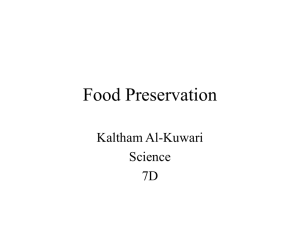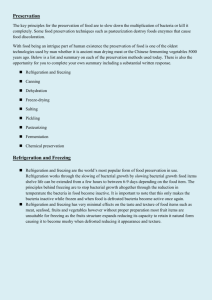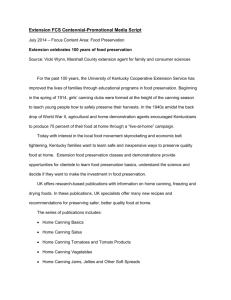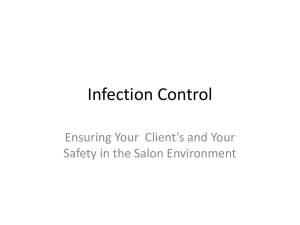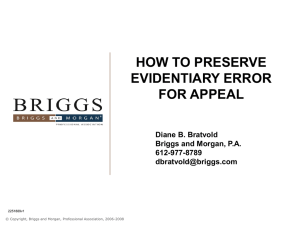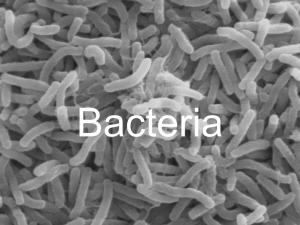2014 Acidified Foods part 1
advertisement
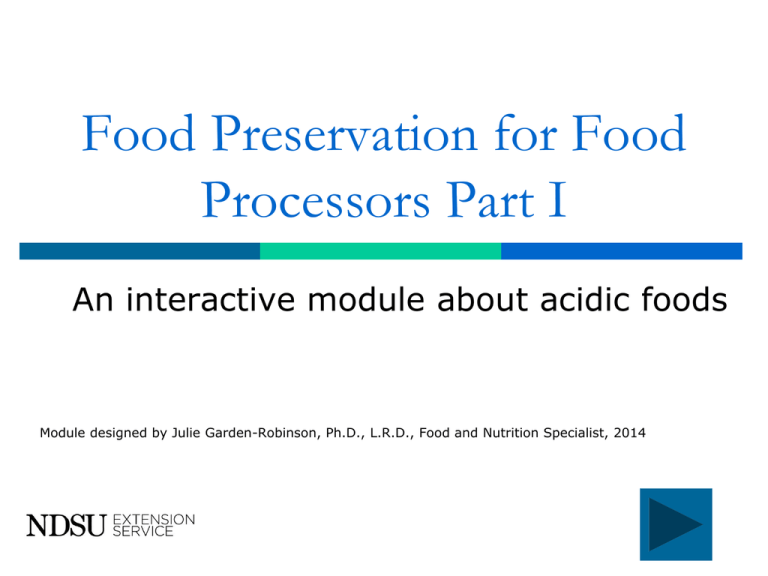
Food Preservation for Food Processors Part I An interactive module about acidic foods Module designed by Julie Garden-Robinson, Ph.D., L.R.D., Food and Nutrition Specialist, 2014 The following tips will help you navigate through each module. Click to go back and to move forward in the module. Before you begin, you’ll take a pretest. The pretest will open in a new window. When you are finished with the pretest, close the window to return to the module. A symbolizes a question slide. You’ll need to click forward to see the answer. Click this button to return to your position in the module after reading the definition slide. When you are finished with the module, you will take a post-test. The post-test will open in a new window. When you are finished with the post-test, close the window to return to the module. Pretest Before we begin, let’s take a pretest to see how much you already know. Click here for the pretest. Have a bright idea? Everyone loves my salsa and always asks me to bring it to potlucks. Maybe I should start selling it. I bet I could make a fortune. Maybe I can retire and buy a house in Arizona – no, Florida. Heck, maybe both! Oh, no! There are regulations? Hey, wait. Don’t give up. Go through this interactive module. It tells you what you need to know about processing acidified foods. Salsa is an acidified food. Before we discuss the acidification process and regulations, let’s go over some basics about types of preservation and also what preserving means. Food Preservation Definition: The process of treating and handling food in such a way that it stop or greatly slows spoilage to prevent foodborne illness while maintaining nutritional value, density, texture and flavor. Factors that affect food spoilage Water availability (moisture) Oxygen pH Temperature True or false: Oxygen is a factor affecting food spoilage. a. b. True False Click the forward button to see the answer. True or false: Oxygen is a factor affecting food spoilage. a. b. True False Oxygen is a factor affecting food spoilage. Water Availability “Water availability” refers to the amount of water available for microbial growth. It is shown on a scale from 0 to 1. Bacteria grow in moist environments, so the higher the water availability, the greater the risk for microbial growth. A solute such as salt or sugar added to water “soaks” up the water, making it unavailable for bacterial growth. Water Availability Scale 0aW Bone dry 0.8aW 0.2aW Very dry (instant coffee, milk powder, etc.) 0.6aW Dried fruit 1aW 0.99aW Pure Moist water fresh food (meat/fish) Water Availability Bacteria, mold and yeast need a certain amount of water available to grow. As the water availability decreases, bacteria, mold and then yeast cease to grow. Bacteria stop growing below 0.85aW Molds stop growing below 0.75aW Yeast stops growing below 0.6aW Water availability of some common foods Food Example Water Availability Cheese spread 0.95 Soy sauce 0.80 Fudge sauce 0.83 Soft, moist pet food 0.83 Peanut butter 0.70 Dry milk 0.70 Liverwurst 0.96 Salami 0.82 *Water availabilities greater than 0.85 support bacterial growth. True or false: High water availability supports bacterial growth. a. b. True False Click forward to see the answer. True or false: High water availability supports bacterial growth. a. b. True False Most bacteria grow best in products with high water availabilities. Oxygen Aerobic reactions need oxygen. The browning of fruit is one example. Anaerobic reactions do not require oxygen. Clostridium botulinum is a type of bacteria that does not need oxygen to survive. Fill in the blank: Bacteria that need oxygen to survive are ______. a. b. Aerobic Anaerobic Click forward to see the answer. Fill in the blank: Bacteria that need oxygen to survive are ______. a. b. Aerobic Anaerobic Aerobic bacteria need oxygen to survive and grow. pH Foods have different pH values. Chemical reactions are decreased at very high and very low pH. A pH meter is used to determine the pH level of foods. Temperature Warm temperatures increase chemical reactions. High temperatures can kill harmful microorganisms. High temperatures are critical for certain preservation methods: Pressure canning Boiling-water canning Low temperatures can slow and eventually stop chemical reactions. Preserve foods by: Adding an acid Adding salt Drying to remove moisture Adding sugar Adding chemical preservatives Heating Vinegar + (Acid) Now that we know what to control to prevent food from spoiling, let’s review some methods of preservation. Types of preservation: Drying Curing and smoking Freezing and refrigeration Fermentation Pressure canning Making jam and jelly Pickling/acidification Which of the following is a preservation method? a. b. c. d. Drying Freezing Smoking All of the above Click the forward button to see the answer. Which of the following is a preservation method? a. b. c. d. Drying Freezing Smoking All of the above “D” is the correct answer. Drying One of the oldest methods of preservation Removes moisture to delay and prevent bacterial growth Safe and easy-to-learn method of preservation A food dehydrator often is used Meats and fruits, such as jerky, apples, bananas, mangos and tomatoes, are popular items to dry Fill in the blank: Drying preserves food by ______. a. b. c. adding an acid lowering the temperature reducing the moisture content Click the forward button to see the answer. Fill in the blank: Drying preserves food by ______. a. b. c. adding an acid lowering the temperature reducing the moisture content “C” is the correct answer. A food dehydrator or oven on a low temperature is used to dry foods for preservation. Curing and Smoking Meats must be cured before they are smoked. Curing uses salt to reduce the moisture available to microorganisms. Nitrates and nitrites are added to inhibit the growth of Clostridium botulinum. Curing can take several hours to several weeks. Fill in the blank: Curing preserves food by ______. a. b. c. adding an acid lowering the temperature reducing the moisture content Click the forward button to see the answer. Fill in the blank: Curing preserves food by ______. a. b. c. adding an acid lowering the temperature reducing the moisture content "C” is the correct answer. Salt is added to products being cured to reduce the moisture content. Smoking After a product is cured, it can be smoked. Smoking usually is done in a smokehouse. The combination of heat and smoke dries and preserves the food. Smoking adds flavor to the product. Meat, poultry, game and fish all can be smoked. Freezing and Refrigeration Are commonly used processes for preserving Stops the growth of bacteria (freezing) or slows the growth of bacteria (refrigeration) Slows most chemical reactions Does freezing food kill bacteria? a. b. Yes No Click the forward button to see the answer. Does freezing food kill bacteria? a. b. Yes No “B” is the correct answer. Bacteria is not killed by freezing foods, but the lower temperature slows the growth of bacteria. Fermentation A microorganism such as yeast is added to a product to convert carbohydrates into an acid or an alcohol. These microorganisms consume the food and produce byproducts. Yogurt is one example. Bacteria is added to milk. The bacteria eat the sugar and produce lactic acid. Lactic acid reduces the pH of yogurt, which inhibits bacteria growth. Which preservation method involves bacteria or yeast? a. b. c. d. Drying Fermenting Pickling Freezing Click the forward button to see the correct answer. Which preservation method involves bacteria or yeast? a. b. c. d. Drying Fermenting Pickling Freezing “B” is the correct answer. Yogurt is an example of fermentation. Pressure Canning Kills bacteria with high temperatures. A temperature greater than 240 F must be reached. Pressure canning is used when the product has a pH above 4.6. Jams and Jellies Sugar reduces the amount of available water. Jams and jellies normally have a pH lower than 4.6. Jams and jellies cook during processing. Post-test Now you have some basic knowledge about why we preserve food and the methods of food preservation. Before you move on to the next module, let’s take a post-test to see what you’ve already learned. Click here to take the post-test Learn more about food preservation with the following online resources National Center for Home Food Preservation FDA - Acidified and Low Acid Canned Foods www.uga.edu/nchfp/ www.fda.gov/food/guidanceregulation/guidanc edocumentsregulatoryinformation/acidifiedlacf/ default.htm NDSU Extension Service Food Preservation and Storage www.ag.ndsu.edu/food

